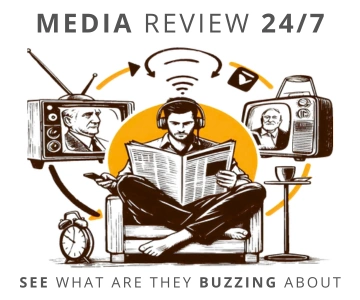 Photo: DataArt
Photo: DataArtThis year will see further integration of new technologies, entertainment, and social media, DataArt experts predict. A key factor will be the development of 5G networks, enabling a new level of connectivity with instant access to content anytime and anywhere. This technology is expected to bolster an industry already moving toward on-demand services, potentially equating subscription revenues with advertising revenues - even in areas traditionally dominated by ads.
Personalization Will Be Key
This trend will drive the exponential growth of the value of intellectual property in media, music, and sports. While industry giants like Netflix, Amazon, Google, Facebook, and Apple will maintain their dominance, other players will need to carve out niches with well-defined products, personalized microservices, and unique offerings. This challenge may lead to increased competition or market consolidation.
The competition for market share will intensify, with technology serving as the critical tool for success. Personalization of content, as demonstrated by Netflix, will be crucial. For example, Bloomberg reported in October that Netflix`s new season of "Black Mirror" would allow viewers to decide on the storyline or ending of each episode - a concept borrowed from video games that could soon become a staple on the "silver screen."
Personalization vs. Compliance
Challenges related to data security and privacy regulations will complicate this battle. Personalization can only thrive within legal boundaries and users` willingness to share information. While technology expands the possibilities for personalization, regulations may impose limitations. Compliance becomes even more challenging with new laws that not only change legal frameworks but also impact trust between companies and consumers.
Those who overcome these challenges will be able to focus on intelligent data collection, analysis, and visualization - key factors for success in content creation, distribution, and monetization.
AI, VR, AR
Artificial intelligence is likely to play a significant role in this transformation. AI will enhance personalized advertising, content recommendations, and even content creation. Virtual assistants, combining analytical and communication skills, are emerging as promising tools for creating more personalized and human-like interactions.
Technologies like virtual and augmented reality, along with 360-degree images and videos, will further personalize experiences by enabling consumers to create virtual environments from scratch. VR and AR are already making their way into entertainment, sports, journalism, and education.
Shifting Revenue Structures
A shift in the revenue structure of the industry will be another indicator of this evolution. Historically, two-thirds of revenues came from hardware. However, as technology becomes more advanced and accessible, software is poised to take a larger share of growth. Augmented reality technologies are set to outpace virtual reality, making AR the dominant segment in the near future.
COMMERCIAL BREAK
New articles in section Media industry
Advertising market 2025. Poland, Europe and the World
Marcin Grządka
The global advertising market is growing by 8.8% in 2025 and will reach a value of 1.14 trillion dollars. The industry result in Europe records slightly lower dynamics, at the level of 5.8%. In this comparison, Poland performs clearly above the average. We will record an increase of 8.9% this year and a value of 18.56 billion PLN - estimates WPP Media in the annual report "This Year Next Year".
The print media market 2025. Three global trends
Krzysztof Fiedorek
The market value is 359.53 billion dollars, yet the erosion is visible to the naked eye. The decline for newspapers will amount to -2.3 percent. Despite this, print retains strength: it generates 76 percent of subscription revenues and enjoys 82 percent consumer trust. The future of the industry is defined by hybrid strategies and niche specialization.
Journalism in the age of AI. Why people prefer humans over machines
Krzysztof Fiedorek
Only 12% of people accept news created solely by AI, while 62% prefer those written by humans. At the same time, only 19% notice labels indicating the use of artificial intelligence, while younger audiences ask AI to explain the content to them. These are the findings of the Reuters Institute report on artificial intelligence in media.
See articles on a similar topic:
New Individual Mass Media (Mass Self Communication)
Grzegorz D. Stunża
In the latest issue of "Le Monde Diplomatique," there’s an article by Manuel Castells titled "Individual Mass Media." The author points out that media, once subjective and often party-affiliated (as with newspapers), only briefly moved away from one-sidedness when under various pressures.
Can a Robot Be Good Boss? Researchers from SWPS Look for Answers
SWPS
A robot giving orders at work is no longer a science fiction scenario - it's a research topic. Scientists from SWPS University in Poland set out to find out whether a robot can effectively manage human workers.
Hate speech is contagious and leads to harm [EXPERT OPINION]
Karolina Kropiwiec
‘If we are in an environment where certain groups of people are insulted, there is a high probability that we will start using such language ourselves; hate speech is contagious and its consequence is someone's harm,’ says Dr. Michał Bilewicz from the Centre for Research on Prejudice at the University of Warsaw.
Women in media 2025. Editorial power knows no equality
KFi
Only 27% of editors-in-chief in the media are women, even though they make up 40% of journalists. In 9 out of 12 countries studied by the Reuters Institute, women in media are less likely to get promoted. It seems that equality in newsrooms is lagging behind broader society. And the gaps go much further.





























